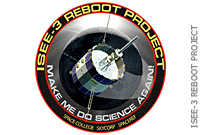
The ISEE-3 Reboot Project is pleased to announce that our team has established two-way communication with the ISEE-3 spacecraft and has begun commanding it to perform specific functions. Over the coming days and weeks our team will make an assessment of the spacecraft’s overall health and refine the techniques required to fire its engines and bring it back to an orbit near Earth.
First Contact with ISEE-3 was achieved at the Arecibo Radio Observatory in Puerto Rico. We would not have been able to achieve this effort without the gracious assistance provided by the entire staff at Arecibo. In addition to the staff at Arecibo, our team included simultaneous listening and analysis support by AMSAT-DL at the Bochum Observatory in Germany, the Space Science Center at Morehead State University in Kentucky, and the SETI Institute’s Allen Telescope Array in California.
Of course this effort would not have been possible without the assistance of NASA and the Space Act Agreement crafted by NASA Headquarters, NASA Ames Research center, and the System Solar System Exploration Research Virtual Institute (SSERVI).
For further information on the ISEE-3 Reboot Project please visit our website at http://spacecollege.org/isee3 A much more detailed description of our First Contact efforts and future plans will be published on our website next week.
Here is how to stay up to date on our progress
Twitter: http://twitter.com/isee3reboot
Facebook: http://www.facebook.com/ISEE3Reboot
Google+: http://plus.google.com/110871408384252629393/
Web: http://spacecollege.org/isee3
 About The ISEE-3 Reboot Project
About The ISEE-3 Reboot Project
Our plan is simple: we intend to contact the ISEE-3 (International Sun-Earth Explorer) spacecraft, command it to fire its engines and enter an orbit near Earth, and then resume its original mission – a mission it began in 1978. ISEE-3 was rechristened as the International Comet Explorer (ICE). If we are successful it may also still be able to chase yet another comet.
Working in collaboration with NASA we have assembled a team of engineers, programmers, and scientists – and have a large radio telescope fully capable of contacting ISEE-3. If we are successful we intend to facilitate the sharing and interpretation of all of the new data ISEE-3 sends back via crowd sourcing.
NASA has told us officially that there is no funding available to support an ISEE-3 effort – nor is this work a formal priority for the agency right now. But NASA does feel that the data that ISEE-3 could generate would have real value and that a crowd funded effort such as ours has real value as an education and public outreach activity.
Time is short. And this project is not without significant risks. We need your financial help. ISEE-3 must be contacted in the next month or so and it must complete its orbit change maneuvers no later than mid-June 2014. There is excitement ahead as well: part of the maneuvers will include a flyby of the Moon at an altitude of less than 50 km.
Our team members at Morehead State University, working with AMSAT-DL in Germany, have already detected the carrier signals from both of ISEE-3’s transmitters. When the time comes, we will be using the large dish at Morehead State University to contact the spacecraft and give it commands.
In order to interact with the spacecraft we will need to locate the original commands and then develop a software recreation of the original hardware that was used to communicate with the spacecraft. These are our two greatest challenges.
The funding we seek will be used for things we have not already obtained from volunteers. We need to initiate a crash course effort to use ‘software radio’ to recreate virtual versions all of the original communications hardware that no longer physically exists. We also need to cover overhead involved in operating a large dish antenna, locating and analyzing old documentation, and possibly some travel.
This activity will be led by the same team that has successfully accomplished the Lunar Orbiter Image Recovery Project (LOIRP): SkyCorp and SpaceRef Interactive. Education and public outreach will be coordinated by the newly-formed non-profit organization Space College Foundation.
Our trajectory efforts will be coordinated by trajectory maestro Robert Farquhar and his team at KinetX. We are also working in collaboration with the Science Mission Directorate at NASA Headquarters, NASA Goddard Spaceflight Center, and the Solar System Exploration Research Virtual Institute (SSERVI) at NASA Ames Research Center.
For information contact Dennis Wingo at 310-403-1346 or by email at wingo -at- skycorpinc.com